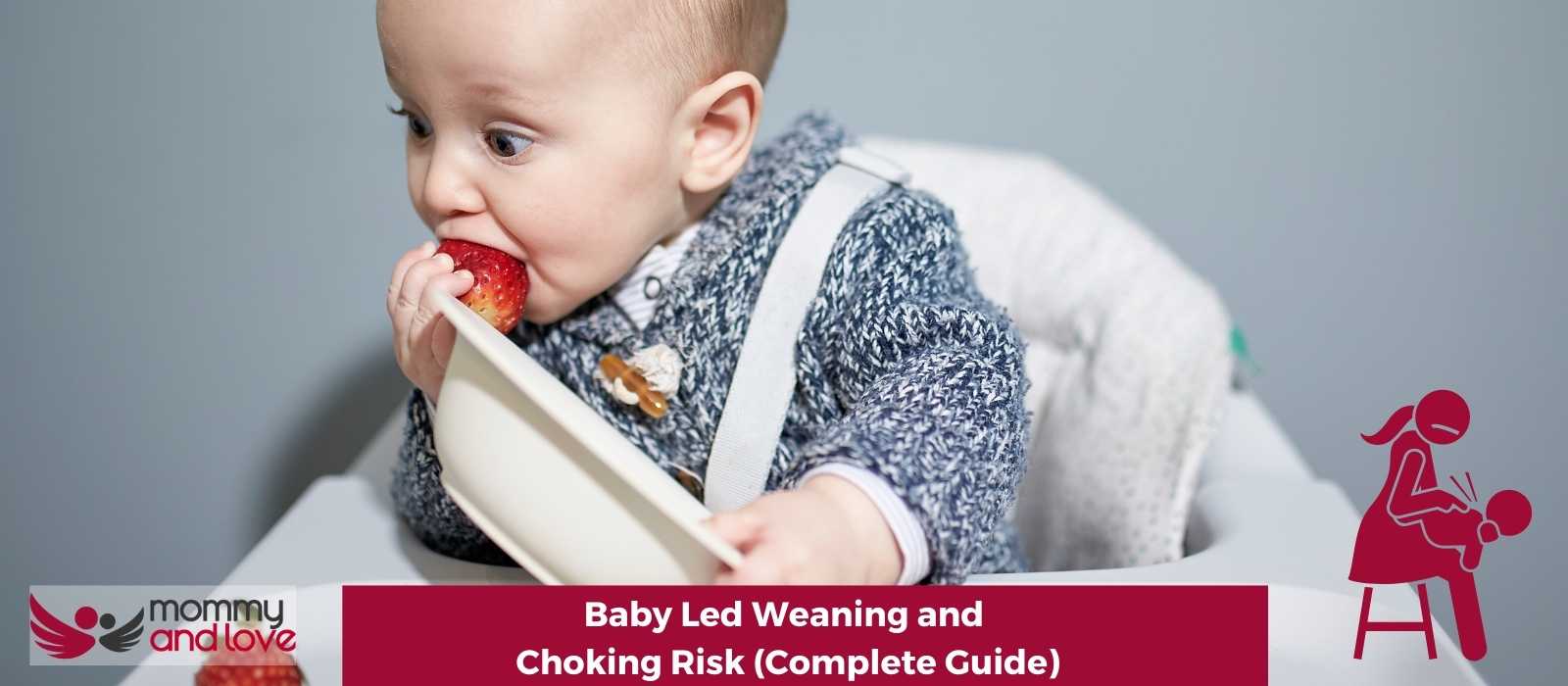If your baby is ready to wean onto solid foods, you might be considering trying baby led weaning, but fears of baby-led weaning choking is putting you off. Are these fears true? Does a baby led weaning approach lead to high choking risks in babies?
Some people believe that baby-led weaning is a safer way for babies to eat, but there is a risk of choking. In this guide, we will discuss the risks associated with baby led weaning and how you can protect your child from choking hazards.
Do Baby Led Weaners Choke More?
We’ve done a full guide to baby-led weaning here, but essentially it’s giving your baby finger goods rather than puree feeding. There are many benefits to baby led weaning over spoon-fed babies, but there is a risk of a choking baby.
Whilst spoon-feeding purees might seem easier, and there will be significantly more choking episodes when you allow the baby self feed, as long as you are monitoring your baby when they are eating and never leave them eating alone, things should be fine.
However, it’s important to note the difference between choking and a gag reflex, to know the high choking risk foods and what to do if your baby does choke when they start to eat finger foods. When a baby bites, their gag reflex will automatically start to reject the food, its not baby choking, its natural and part of growing up. It will lesson as they mature.
Even though you are following a loose baby led approach, you still need to follow safe feeding practices. This includes putting a baby in a high chair and ensuring that food is smaller than choking hazard size, and always start with safe finger foods. We’ve done a detailed BLW food guide here.
What to do if your child chokes
It’s every parent’s nightmare, isn’t it?
Your child pops something into their mouth and the next minute they’re choking and going blue…..
Unfortunately, choking events happen more often than you think. Only recently, the papers were full of a story about a mom who was wheeling her baby around a store in a buggy. As the mom looked at the fruit and veg, her baby reached out and pulled a grape from a bunch, popped it into their mouth…..and choked to death.
Beyond scary to think about….
Unfortunately, one of the ways that babies explore the world around them is by putting things into their mouths.
Because of their age, they don’t always chew, swallow and breathe in the right order, and this can lead to choking or to baby gagging.
Baby Led Weaning Choking on food
You may be surprised to know that food is the most common cause of choking in infants, so it goes without saying that it’s vitally important to introduce only age-appropriate foods to your child after they turn 6 months old.
When you introduce solids always start with soft food for baby feed.
Also, ensure that baby is not distracted by their surroundings when self-feeding. A distracted baby can easily lead to a choking episode.
High Choking Risk Food

The following foods should be specially monitored when your child is eating them as they are considered a choking hazard.
That said there is no real safe finger foods and you should always monitor your children when they are eating solids or finger food, especially hard foods.
- grapes (make sure these are cut in half – AT LEAST – quarter them if you have the time)
- hot dogs
- chunks of raw fruits or vegetables
- chunks of meat or cheese
- popcorn
- whole nuts and seeds
- peanut butter (Although nut butter is a purée, it’s the thickness and stickiness that make it hazardous for young children)
- marshmallows
- hard candies
- chewing gum
- cherry tomatoes
- Raw apple
- raw carrot
- hard fruits
- hard vegetables
- green beans
Now, we know that, as a sensible and caring mom, you’re not going to give your baby chewing gum or hard candy – but what about if your baby found some on the ground?
Little eyes can see things on the floor and little hands can scoop them up and pop them into their mouth in a flash….so always be vigilant!
It is also possible for very young babies to choke on liquids, such as breast milk or formula. They may even choke on their own spit-up or mucus. This is mainly because their airways are particularly small and so are easily obstructed.
What to Do if Your Baby Starts Choking

First of all, you need to clarify that your baby is actually choking.
They may actually be only coughing or gagging. In fact, the fact that there is noise at all would indicate that they are coughing or gagging since, if they were actually choking, there would be no noise because their airway would be completely blocked.
If your baby is choking then it’s vitally important to call 911. If you are with others, get one of them to call 911 while you help your baby through this difficult situation. Either you or the person who calls 911 needs to explain the situation clearly to the operator and provide updates about the measures that you’re taking to remedy the situation.
Remember – you must NEVER do the Heimlich manoeuver on a baby. This involves abdominal thrusts from behind – you’ve probably seen it in films and TV programmes. You cannot do this on a baby or young child as you mustn’t squeeze their tummy.
You can, however, safely give chest thrusts to a baby so, if blows to the baby’s back don’t dislodge the object, chest thrusts are an option.
Okay, so here are the important steps that you need to take….
Step 1 – Infant CPR
Lay your baby face down along your thigh, with their head lower than their bottom.
This is because, with babies, the blockage can often be a liquid (milk curds or mucus), so ensuring that the baby’s head is lower than their bottom means that gravity can play its part in helping the liquid to drain out.
Make sure that your baby’s head and shoulders are supported.
Then, hit them firmly between their shoulder blades with the heel of your hand. You can do this up to five times.
These blows should be strong and applied quickly in order to be effective.
The force of the back blows should be age-appropriate. With a baby or a smaller child, you’ll obviously need to be more gentle than you would with an older child.
The force should also be relative to your own strength.
If the blows to their back don’t succeed in dislodging the object, move on to step two.
Step 2
Turn your baby over so that they are facing upwards.
Again, lay them along your thigh, keeping their head lower than their chest.
Place two fingers – your index and middle fingers – in the middle of their chest, just below the nipples.
Push sharply downwards up to five times, applying enough pressure to press baby’s chest down about one third. This manoeuver helps to push air from the lungs into the airway in a bid to force the object out. (These are the chest thrusts mentioned above.)
Step 3
If the object still hasn’t dislodged, repeat the back blows as described in step 1, following the same instructions above. Follow these up again with repetition of the chest thrusts in step 2.
If either of these moves fail to dislodge the object, and you haven’t already done so, it’s vitally important that you call 911 at this point.
Things you must NEVER do
If your baby has a bottle, make sure that you always hold the bottle while they’re feeding. Never leave your baby to feed themselves and don’t prop up a bottle. That’s because, if your baby was to choke, they wouldn’t be able to push the bottle away.
Don’t leave your baby alone when they’re eating. Once they start to feed themselves, make sure you cut their food into small, manageable pieces. Remember, babies can choke on something as small as a grape!
Never try to pull the object out with your fingers. Not only do you risk pushing the object further down, but you risk hurting the soft tissue at the back of your baby’s throat. This could swell and cause further damage.
Although choking incidents can be very upsetting – for you and your baby – in the vast majority of cases, you’ll see whatever is causing the blockage coming out of your baby’s mouth and they’ll be able to start breathing again.
FAQs on baby led weaning and choking
Can babies choke during baby-led weaning?
Yes, babies can choke during baby-led weaning. This is a risk that comes with any type of feeding method. However, there are steps you can take to reduce the risk of your child choking.
There are several risks associated with baby led weaning. The most serious risk is that your child could choke. Choking can be a life-threatening emergency, so it is important to take precautions to reduce the risk of your child choking.
There are several things you can do to protect your child from choking hazards. The most important thing is to be aware of the potential dangers and take steps to prevent your child from being exposed to them. You can also educate yourself on the signs of choking and how to respond if your child starts to choke.
How often do babies choke during baby-led weaning?
There is no one definitive answer to this question. Some babies never choke during baby-led weaning, while others may choke occasionally. However, the majority of babies do not experience any problems with choking during this process.
It is important to always stay close to your baby when he or she is eating, and to keep a close eye on them, in order to prevent any choking incidents. If your baby does choke, be sure to remain calm and take the necessary steps to help them recover.
Choking is a relatively common occurrence duringweaning, but it is not usually a cause for concern. With close supervision, your baby should have no trouble safely enjoying this process.
Is gagging normal with baby-led weaning?
Yes, it is common for babies to gag while they are learning to eat solid foods. This is typically nothing to worry about, and your baby will likely outgrow this phase in a few months. However, if your baby seems to be gagging frequently or experiences other symptoms such as vomiting or difficulty breathing, please consult your pediatrician.
Gagging is a normal reflex that helps babies to avoid choking. When your baby takes a bite of solid food, the food will enter their mouth and their tongue will push it down their throat. This will cause the back of their throat to close off, which will force the food to go back up. This process is called retching, and it is how babies learn to eat solid foods.
Some babies will gag more than others, and this is perfectly normal. Gagging is not a sign of choking, and your baby will not choke as long as they are swallowing properly. If your baby starts to gag, you can help them by gently patting their back or rubbing their stomach.
If your baby is gagging frequently or experiences other symptoms such as vomiting or difficulty breathing, please consult your pediatrician. Gagging is a normal reflex that helps babies to avoid choking, but it can also be a sign of something more serious.
What is the Gag Reflex?
The gag reflex is a reflex that causes the body to expel foreign objects from the mouth. The reflex is usually caused by the presence of something in the throat that stimulates receptors in the back of the throat. These receptors send a signal to the brain, which then triggers the gag reflex.
The gag reflex can be triggered by many things, including food, saliva, vomit, and mucus. It can also be triggered by objects that are not normally found in the mouth, such as finger food for babies learning to wean.
The gag reflex is usually strongest when something is placed at the back of the throat. However, it can also be triggered by things that are placed in the front of the throat.
The gag reflex can be a nuisance, but it also serves an important purpose. The reflex helps to keep foreign objects from entering the lungs and causing respiratory problems. It also helps to prevent choking.
A baby’s gag reflex is usually stronger than an adult’s gag reflex. This is because a baby’s throat is smaller and the receptors are closer to the surface. As a baby grows, their gag reflex becomes weaker.
The Bottom Line on Baby Led Weaning and Choking
Baby-led weaning is a process by which babies are introduced to solid foods by being allowed to feed themselves. This method is growing in popularity, as it allows babies to learn how to eat on their own and develop a healthy relationship with food.
However, some parents may be concerned about the risk of choking while baby-led weaning. Choking is a relatively common occurrence during this process, but it is not usually a cause for concern. With close supervision, your baby should have no trouble safely enjoying this process.
If your baby does choke, be sure to remain calm and take the necessary steps to help them recover. Choking is a serious problem that can lead to death if not treated properly. However, with proper supervision and care, baby-led weaning can be a safe and enjoyable experience for both you and your child.

This article was written by Sandra Baker – full time writer and the mother of four amazing kids (including twins!)
She’s also a breastfeeding counselor and has spent years helping new parents learn how to care for their children. When she’s not writing or caring for her children, Sandra likes to spend time reading and taking walks with her husband.




